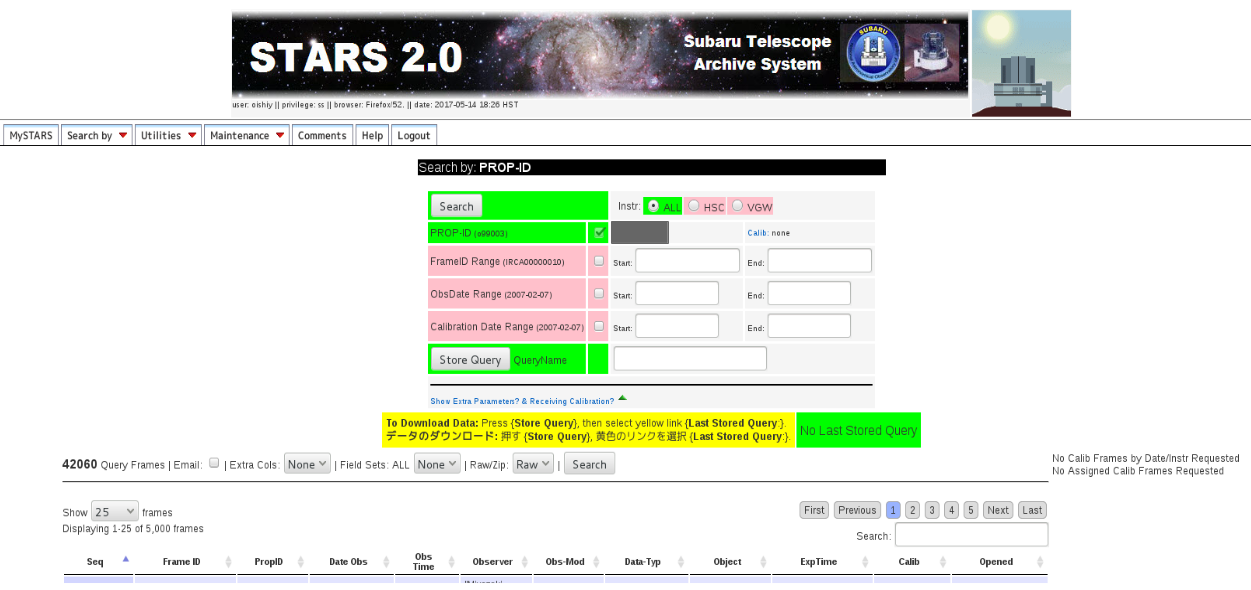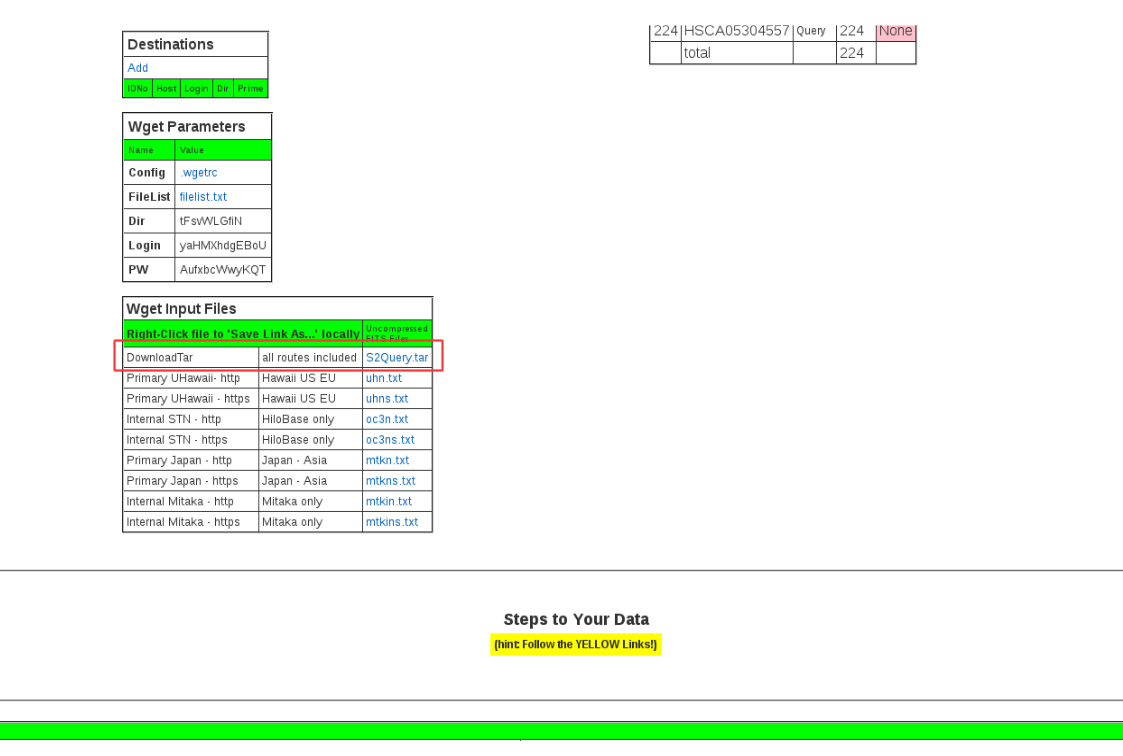Preparation¶
How to download raw data and preparation before starting data reduction are described below.
Downloading HSC raw data¶
Warning
Please read BIAS, DARK and FLAT data before you download calibration data for your run.
You can download your observed data via STARS (Subaru Telescope Archive System) .
After login to STARS, you can see the page like figure 1. From Search by tab, choose Proposal_ID Instrument and Proposal_ID, then select your proposal ID.
After selecting your proposal ID, you can find new page (figure 2)
If you need all data belonging to the proposal ID, request the data via Store Query button. If you want to obtain some specific frames, specify the range of data frame in FrameID Range, save with arbitrary name, and click Store Query button.
Then you will receive “STARS2 Stored Query” message by e-mail. Please download the data following its instruction. You can also get a script for data downloading (S2Query.tar) from MySTARS tab. In the tab, choose the QueryName which you saved in previous step and find the page “One Query” (figure 3). S2Query.tar can be downloaded at the bottom of this page.
To download your raw data with S2Query.tar, follow the way shown below.
# Create a directory for storing raw data (named “rawdata” in this example).
mkdir ~/rawdata
# Move S2Query.tar to raw data if S2Query.tar is in ~/Downloads
cd rawdata
mv ~/Downloads/S2Query.tar .
# Expanding
tar xvf S2Query.tar
# Execute download script in /zadmin
./zadmin/unpack.py
# After execution, please select appropriate network which you use.
Once your downloading is finished, you can find HSCA*.fits in ~/rawdata directory. Refer to Naming rules of raw data for raw data name.
Prepare directories and setting data¶
Once you downloaded your data, you need to create a directory for data reduction and setup data. In this section, 1) creating a directory for reduction and _mapper file, 2) setting Brighter-Fatter kernel, 3) creating links to reference catalog, 4) Set up the data of the transmission curve for HSC filters, 5) Set up the data of CCD defects, 6) Y-band Stary Light are described.
If you do not use a binary package, you need to set one by one. The detailed ways are described below.
Creating a directory for reduction and _mapper file¶
_mapper file indicates which equipment is used.
Warning
The reduction does not proceed without _mapper file.
# Reset the environment variable, if necessary.
unset LD_LIBRARY_PATH
# Register the setup commands
source ~/opt/hscpipe/8.4/bashrc
# Setup environment variables with hscPipe setup command
setup-hscpipe
# You need to do the above commands every login.
# Create a directory for reduction (in case of ~/HSC)
mkdir ~/HSC
# Create _mapper file
echo 'lsst.obs.hsc.HscMapper' > ~/HSC/_mapper
Setting Brighter-Fatter kernel¶
For hscPipe 5 and later, you need to copy the kernel which removes the brighter-fatter effect (whereby brighter stars are enlarged due to detector physics) under ~/HSC/CALIB. If you execute create-rootdir.sh included in binary package, this step has already been done. If you set the kernel manually, please follow the instruction below.
# Make BFKERNEL directory (you have to name "BFKERNEL") under ~/HSC/CALIB
mkdir ~/HSC/CALIB/BFKERNEL
# There is brighter_fatter_kernel.pkl in $OBS_SUBARU_DIR/hsc/, so create link to it.
cd ~/HSC/CALIB/BFKERNEL
ln -s $OBS_SUBARU_DIR/hsc/brighter_fatter_kernel.pkl
Creating links to reference catalog for astrometry¶
In the CCD processing, the astrometric and photometric calibration are performed using reference catalog.
Note
While you need to execute setup astrometry_net_data command at every login for hscPipe4 or earlier, you just need to create a link below only once for hscPipe5 or later.
# Assume that catalog files are under ~/astrometry_data/.
# Create ref_cats directory (the directory name must be "ref_cats"!).
mkdir ~/HSC/ref_cats
# Move to ref_cats, and create link to reference catalog.
cd ~/HSC/ref_cats
ln -s ~/astrometry_data/ps1_pv3_3pi_20170110
Set up the data of the transmission curve for HSC filters¶
From hscPipe6, you have to set up the data of the transmission curve for HSC filters by yourself. To do this, type:
installTransmissionCurves.py ~/HSC
Set up the data of the CCD defects¶
From hscPipe8, you have to set up the data of the CCD defects by yourself. To do this, type:
ingestCuratedCalibs.py ~/HSC --calib ~/HSC/CALIB $OBS_SUBARU_DATA_DIR/hsc/defects
Y-band stray light¶
HSC has had some features known as “The Eye of Y” in the y-band images due to LEDs used in the instrument encoders (https://community.lsst.org/t/y-band-stray-light-correction-for-hsc/2517). From hscPipe6, you need the stray light data to process Y-band images.
# Download and unzip the stray light pattern file.
curl -L https://hscdata.mtk.nao.ac.jp/hsc_bin_dist/STRAY_LIGHT.tar.xz | tar -xJf -
# Link to it (assuming the stray light file you downloaded is in ~/STRAY_LIGHT).
ln -s ~/STRAY_LIGHT ~/HSC/CALIB/
Setting a registry for raw data¶
The raw data downloaded from STARS should be moved to the repository for hscPipe processing and registered. The command “ingestImages.py” is used.
# Move the raw data to a directory for data reduction, create a registry and register the raw data.
# Assume that raw data are in ~/rawdata.
# Specify the directory with absolute path.
ingestImages.py ~/HSC ./rawdata/*.fits --mode=link
# ingestImages.py [directory for data reduction] [raw fits file name] --mode=[move,copy,link,skip]
# Options are,
# --mode: Mode of delivering the files to their destination.
If you choose "link", the link to raw data is created.
The new directories, such as [Object Name], DARK, and DOMEFLAT and a registry registry.sqlite3 are generated under ~/HSC. The structure of these directories should be ~/HSC/[Object Name, BIAS, DARK, DOMEFLAT]/[dateObs]/[opinting]/[filter]/HSCA*.fits.
The contents of registry.sqlite3 can be checked by SQL. If you are interested in SQL, please check other materials.
# Open registry.sqlite3 with SQLite.
sqlite3 registry.sqlite3
# Read header information.
sqlite> .header on
# Display data.
sqlite> SELECT visit, filter, field, count(visit)
...> FROM raw # Select raw table in the registry.
...> GROUP BY visit, filter, field; # Order of display, visit > filter > field
# You can write it in one line, "select filter, field, visit, count(visit) from raw group by visit;"
# Results
visit|filter|field|count(visit)
17636|HSC-Z|DOMEFLAT|112
17638|HSC-Z|DOMEFLAT|112
17640|HSC-Z|DOMEFLAT|112
17642|HSC-Z|DOMEFLAT|112
17644|HSC-Z|DOMEFLAT|112
17646|HSC-Z|DOMEFLAT|112
18336|HSC-I|DARK|112
18350|HSC-Y|DARK|112
.....
# Quit
sqlite> .q
Please verify that the number of all “count(visit)” column is 112 which indicates all the 112 CCDs are included in 1 visit. You can also check the registered visit number of each filter and each field.
Warning
The task of hscPipe sometimes proceeds even if any CCD data is lacking. So please check that all visits have 112 CCDs data.



